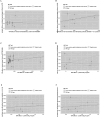A Bidirectional two-Sample Mendelian Randomization Study of the Association Between Venous Thromboembolism and Ischaemic Stroke
- PMID: 39449364
- PMCID: PMC11528786
- DOI: 10.1177/10760296241293333
A Bidirectional two-Sample Mendelian Randomization Study of the Association Between Venous Thromboembolism and Ischaemic Stroke
Abstract
Previous clinical and epidemiological studies have shown that patients with venous thromboembolism (VTE) are comorbid with symptoms of ischaemic stroke (IS). Current understanding about increased risk of IS after VTE remain inconclusive. This study use a bidirectional two-sample Mendelian randomization (MR) study to explore the causality of VTE, pulmonary embolism (PE), deep vein thrombosis (DVT), and IS. This study used pooled data from published genome-wide association studies (GWAS). GWAS statisics of IS (from EBI database, n = 484 121), VTE (from Finngen database, n = 218 792), PE (from Finngen database, n = 218 413), and DVT (from UK biobank database, n = 337 159) were assessed. Forward and reverse MR analysis were conducted to explore the causal relationship between three type of the exposure (VTE, PE, and DVT) and the outcome (IS). Our primary causal inference method was Inverse Variance Weighted (IVW). Secondary inference methods were Weighted Median and MR-Egger. For the sensitive analysis, MR-PRESSO, MR-Egger intercept, Cochran's Q, leave-one method were used to consolidate our findings. In the foward MR analysis, VTE increased the risk of IS (ORIVW = 1.034, PIVW = 0.021) and PE was also a risk factor for IS (OR = 1.055, PIVW = 0.009). There was no causality that DVT influenced on IS (PIVW > 0.05). In the reverse MR analysis, IS came to be a risk factor for DVT (OR = 1.003, PIVW = 0.046). Meanwhile, IS took not any causal effect on VTE and PE. All the results passed the reasonable sensitive analysis. Our findings provided genetic evidence that PE and VTE can lead to an increased risk of IS, whereas increased IS promoted the risk of DVT further. Our findings provided novel insights about the risk factors and management for IS.
Keywords: deep vein thrombosis; ischemic stroke; mendelian randomization; pulmonary embolism; venous thromboembolism.
Conflict of interest statement
Declaration of Conflicting InterestsThe authors declared no potential conflicts of interest with respect to the research, authorship, and/or publication of this article.
Figures
Similar articles
-
Causal effects of childhood obesity on venous thromboembolism in adulthood: A bidirectional Mendelian randomization study.Medicine (Baltimore). 2025 Jun 6;104(23):e42591. doi: 10.1097/MD.0000000000042591. Medicine (Baltimore). 2025. PMID: 40489873 Free PMC article.
-
The genetic causal relationship between type 2 diabetes, glycemic traits and venous thromboembolism, deep vein thrombosis, pulmonary embolism: a two-sample Mendelian randomization study.Thromb J. 2024 Mar 29;22(1):33. doi: 10.1186/s12959-024-00600-z. Thromb J. 2024. PMID: 38553747 Free PMC article.
-
No Genetic Causality between Tobacco Smoking and Venous Thromboembolism: A Two-Sample Mendelian Randomization Study.Thromb Haemost. 2024 Aug;124(8):795-802. doi: 10.1055/s-0044-1781425. Epub 2024 Feb 22. Thromb Haemost. 2024. PMID: 38387601
-
Evidence for causal effects of neuropsychiatric conditions on risk of venous thromboembolism: A univariable and multivariable Mendelian randomization study.J Vasc Surg Venous Lymphat Disord. 2024 Nov;12(6):101889. doi: 10.1016/j.jvsv.2024.101889. Epub 2024 Apr 15. J Vasc Surg Venous Lymphat Disord. 2024. PMID: 38621580 Free PMC article. Review.
-
Venous thromboembolic disease genetics: from variants to function.J Thromb Haemost. 2024 Sep;22(9):2393-2403. doi: 10.1016/j.jtha.2024.06.004. Epub 2024 Jun 21. J Thromb Haemost. 2024. PMID: 38908832 Review.
References
-
- Ding Q, Liu S, Yao Y, et al. Global, regional, and national burden of ischemic stroke, 1990-2019. Neurology 2022; 98(3): e279-e290. - PubMed
-
- Xu S, Ilyas I, Little PJ, et al. Endothelial dysfunction in atherosclerotic cardiovascular diseases and beyond: From mechanism to pharmacotherapies. Pharmacol Rev 2021; 73(3): 924-967. - PubMed
MeSH terms
LinkOut - more resources
Full Text Sources
Medical



